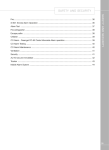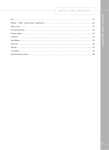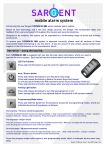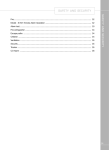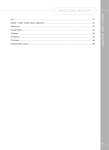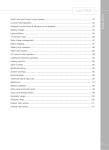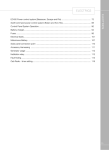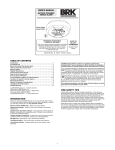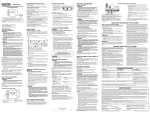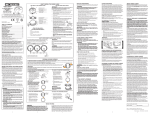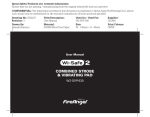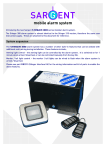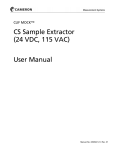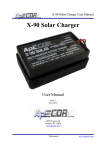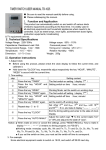Download SAFETY AND SECURITY SAFETY AND SECURITY
Transcript
safety and security SI 601 Smoke Alarm Operation ................................................................................................. 36 Alarm Test ................................................................................................................................. 37 Fire extinguisher......................................................................................................................... 38 Escape paths ............................................................................................................................. 38 Children .................................................................................................................................... 38 CO Alarm - Fireangel CO-9X Carbo Monoxide Alarm operation................................................. 39 CO Alarm Testing ...................................................................................................................... 40 CO Alarm Maintenance ............................................................................................................ 40 sa f e t y a nd s e curit y Fire ........................................................................................................................................... 36 Ventilation ................................................................................................................................ 41 Security ..................................................................................................................................... 41 AL-KO secure immobiliser.......................................................................................................... 42 Tracker ...................................................................................................................................... 43 Mobile Alarm System ................................................................................................................ 44 35 s a fe t y a nd s e curity fire and fire alarm Fire BATTERY REPLACEMENT Important: Your attention is drawn to the notice affixed inside the caravan wardrobe advising on fire precaution, ventilation and what to do in case of fire. IMPORTANT: Only the following batteries can be used for replacement. Use of a battery other than those recommended below may have a detrimental effect on the detector’s operation. Use of a lithium (long-life) battery could provide power for 10 years under normal operating conditions, meaning there is no need for an annual battery change. IN CASE OF FIRE 1.Get everyone out of the caravan as quickly as possible using whichever exit is the quickest, including windows. Do not stop to collect any personal items. 2.Raise the Alarm. Call the Fire Brigade. 3.Turn off the gas supply valve if it is safe to do so. NOTE: Upon delivery the battery may be fitted with a protective cover. Please ensure this is removed before use. 4.Turn off the electricity supply at supply point. Carbon-Zinc type: MODEL- SI 601 SMOKE ALARM OPERATION Eveready Energizer 1222; Gold Peak 16045 (UL). Normal condition Alkaline Type: The red LED on the front should flash once every 40 seconds to show the alarm is active. Energizer 522; Duracell MN 1604; Duracell 9V Low Battery Condition IMPORTANT: Your smoke alarm requires a battery with a sufficient capacity of power to operate correctly. This must also be correctly installed. Should your smoke alarm enter a low battery condition, the unit will emit an audible ‘chirp’ once every 40 seconds. When this occurs you must replace the battery immediately. Your smoke alarm will continue to warn of this low battery condition for at least 7 days, however, failure to change the battery after this time would mean your smoke alarm has insufficient power to alert you in a real fire situation. 36 NOTE: The alarm cover can't be installed without a battery fitted. Ultra; Energizer 9V Ultra+; Gold Peak 1604A. Lithium (long life) type: Ultralife U9VL 1.Remove the alarm from its mounting plate by turning anti-clockwise Fire alarm 3.Replace the alarm on its mounting plate, lining up the large central vent on the front of the alarm, with the ‘X’ that is moulded into the plastic on the mounting plate (if unsure see page 13 of the alarm user manual). Ensure the unit is securely fitted. ALARM TEST 1.Press the test button in the centre and release. sa f e t y a nd s e curit y 2.Remove the existing battery and replace with a new battery. From the list on the previous page, making sure that the positive and negative connections are in the correct position. If unsure see the alarm user manual. 2.The unit will emit a loud (85dB at 3 meters) alarm for around 5 seconds and stop automatically. 3.The red LED on your alarm will flash rapidly during the audible signal. 4.Test your alarm as explained in the next section ‘Alarm Test’. 37 s a fe t y a nd s e curity fire alarm NOTE: The test button accurately tests the alarm’s smoke sensing circuit, there is no need to test your alarm with smoke. If your smoke alarm fails to give an audible test signal, please refer immediately to the troubleshooting guide at the end of the alarm user manual. WARNING: Test your smoke alarm at least once per week Your smoke alarm has been designed to be as maintenance - free as possible and although the unit requires only battery maintenance for its entire life, there are several things you must do to keep it working properly. CAUTION: Your smoke alarm is a sealed electrical device and no attempt should be made to open the case. Attempting to open the case will invalidate your Warranty. TESTING: Test your smoke alarm once every week, see page 38 on how to do this. CLEANING: As a minimum your smoke alarm should be cleaned once every 3 months using your vacuum cleaner fitted with the soft brush attachment. Warning: The electronic test button provides a full test of the unit’s functionality. DO NOT try to test the alarm with a naked flame, as this may present a potential fire hazard. WARNING: Never use portable cooking or heating equipment other than electric heaters that are not of the direct radiant type, as it is a fire and asphyxiation hazard. WARNING: Appliances such as cookers must not be used for heating. Fire Extinguisher It is recommended that a dry powder fire extinguisher be carried inside your caravan at all times. When using a dry powder extinguisher it is suggested that the caravan be evacuated until the powder has settled, to avoid inhalation. A fat pan fire should not have a fire extinguisher aimed at it. It should be smothered with a fire blanket. WARNING: Provide one dry powder fire extinguisher of an approved type or complying with ISO 7165, of at least 1kg capacity, by the main exterior door and a fire blanket next to the cooker. Familiarise yourself with the instructions on your fire extinguisher and the local fire precaution arrangements. WARNING: Your smoke alarm may false alarm when it is being cleaned using a vacuum cleaner. IMPORTANT: Do not use solvents or cleaners on your smoke alarm, as they may cause damage to the sensor or circuitry. The unit can be wiped with a slightly damp cloth. 38 Escape paths It is important that you do not block escape paths to emergency exits with obstructions or hazards. Children Do not leave children alone in the caravan in any event. Keep potentially dangerous items out of reach, as at home e.g. matches, drugs etc. CO Alarm Fireangel CO-9X Carbon Monoxide Alarm WARNING: Please read the full user instructions provided. CARBON MONOXIDE Known as the silent killer, Carbon Monoxide is an invisible, odourless and tasteless gas. What are the symptoms of carbon monoxide poisoning? Early symptoms of carbon monoxide (CO) poisoning can mimic many common ailments and may easily be confused with flu or simple tiredness. Symptoms to look out for include: • tiredness • drowsiness • headaches • giddiness • nausea • vomiting clear and the alarm to stop depending on the level of carbon monoxide detected. • Get medical help immediately for anyone suffering the effects of carbon monoxide poisoning (headache, nausea), and advise that carbon monoxide poisoning is suspected. • Do not use the appliance again until it has been checked by an expert. In the case of gas appliances the engineer must be Gas Safe registered. sa f e t y a nd s e curit y CO ALARM Activating the Alarm See diagram beolw Your detector comes complete with an integrated power pack that will provide power for its entire operational life. To activate the power pack you need to pull the disabling tab (see image). This will in turn pull out the metal disabling clip, which is attached to the end of the tab, from the disabling socket which is situated on the underside of the detector. Retain the disabling tab for future use by taping it to page 20 of the CO-9X user manual. • pains in the chest • breathlessness Normal Operation of the Alarm • stomach pains When the detector is activated the Power LED will begin to flash green once every minute to indicate that the detector is receiving power from the power pack and is fully operational. • erratic behaviour • visual problems Anyone with these symptoms should immediately turn off all appliances and seek medical attention. WHAT TO DO DURING AN ALARM • Keep calm and open the doors and windows to ventilate the caravan. • Stop using all fuel burning appliances and ensure, if possible, that they are turned off. • Evacuate the caravan leaving the doors and windows open. • Do not re-enter the caravan until the alarm has stopped. When exposed to fresh air it can take up to 10 minutes for the sensor to 39 s a fe t y a nd s e curity CO alarm Testing the Alarm Test the sounder, power pack and circuitry by pressing and holding the centre of the Test/Reset button briefly to confirm that the detector is operating properly. The sounder will sound as soon as the button is pressed, and the Alarm LED will illuminate red indicating that the sounder is working and the power pack is providing power to the unit. This test for the sounder, power pack and circuitry should be performed on a weekly basis. This should be continued for the lifetime of the product. WARNING: Prolonged exposure to the sounder in close proximity to your ears may damage your hearing. Under normal operating conditions, the power pack will last for the lifetime of the product i.e 7 years. The detector will not protect against the risk of carbon monoxide poisoning when the power pack has drained IMPORTANT: This does NOT mean that the detector has detected carbon monoxide. Maintenance Your detector will alert you to potentially hazardous CO concentrations in your caravan when maintained properly. To maintain your FireAngel detector in proper working order, and to ensure that the sensor will last for the lifetime of the product, it is recommended that you: • Test the sounder, power pack and circuitry of your detector at least once per week by pressing the Test/Reset button briefly (see above). Sensor Testing. • Perform the Sensor Test once every month (See of the CO-9X user manual for more details). The alarm manufacturer recommends that this is carried out monthly. See the CO-9X user manual for more details. • Keep the detector free of dust by gently vacuuming the case with a soft brush attachment once per month. CO Alarm operation when CO detected The higher the concentration of carbon monoxide detected by the detector, the quicker it will respond. When sufficient carbon monoxide is detected a loud audible signal (85 dB at 1m (3 feet)) will be emitted and the Alarm LED will flash red once every second. To prevent the possibility of contaminating the sensor in your detector and thus affecting its reliability: • Never use cleaning solutions on your detector. Simply wipe with a slightly damp cloth. • Do not paint the detector. The Alarm will sound: • Do not spray aerosols on or near the detector. • Between 60 and 90 minutes when exposed to a minimum of 50ppm of CO. • Do not use any solvent based products near the detector. • Between 10 and 40 minutes when exposed to a minimum of 100ppm of CO. Security chips • Within 3 minutes when exposed to a minimum of 300ppm of CO. Fault / low power pack signal: 40 power pack becomes low then the detector will emit a single chirp once per minute and the Fault LED will flash yellow once per minute for up to 30 days. The unit continuously checks the settings of its sensor and circuitry. If any of these settings are found to be incorrect or if the A special security chip is concealed within the body of every caravan. This chip contains the individual identity of your caravan and can only be read by using a special decoder by police officers. ventilation / security Security All caravans comply with BS EN 721. The ventilation points on your caravan are fixed points of ventilation which are required by the European Standards. Caravan theft All caravans have ventilation at high level and low level which have been calculated to suit the individual needs of your caravan. High level ventilation is achieved by means of the roof lights and washroom roof ventilators. The low level ventilators are positioned underneath the oven housing. Some models with sliding doors have two vents located underneath the sliding doors. The theft of a caravan can occur in the most unlikely circumstances; from a motorway service area, even from an owner’s driveway. Secure all windows and doors when your caravan is unoccupied even if only for a short length of time. Chassis number Under no circumstances must these vents be blocked or obstructed. Your 17 digit serial number chassis number can be found on your windows and on the offside chassis member of the drawbar. It is also stated on the manufacturers weight plate next to the doorway. It is advised that fixed ventilation points are checked and cleaned (if necessary) on a regular basis using a small brush and a domestic vacuum cleaner. Make a note of this number in the space provided at the front of this handbook and make a separate note of the number to keep safe at home. Additional night time ventilation is obtained by releasing the window catches and placing them in the second groove. Note the windows are not sealed from rain in this position. Additional security As the ventilation levels are calculated to suit each models requirements there should be no modifications made which may result in reduced ventilation levels. A hitch lock cover prevents towing of the caravan. WARNING: Do not obstruct ventilation. Petrol/Diesel Fumes The fitting of a tail pipe extension to your car exhaust will reduce the possibility of fumes entering your caravan through the ventilation points. Note: Never allow modification of electrical or LPG systems and appliances except by qualified persons at an authorised Swift Group dealership. sa f e t y a nd s e curit y Ventilation Consider fitting any device which might deter or prevent intrusion by thieves. A wheel lock prevents towing of the caravan and removal of the wheel (some models are provided with an AL-KO Secure device). Customers are advised to identify their caravan with a method for subsequent identification if other forms of identification have been altered or removed. Free crime prevention advice about securing your caravan, protecting your valuables, property marking, either at home or whilst on site, can be obtained from the Crime Prevention Officer through your local Police Station. 41 s a fe t y a nd s e curity al-ko secure immobiliser Caravan insurance It is recommended that the caravan and its contents should be insured against theft. It is essential to check with your car insurance company to ensure you are covered when towing your caravan. YOU MUST REGISTER YOUR KEY WITHIN ONE MONTH OF THE DATE OF PURCHASE. SHOULD YOU FAIL TO DO THIS, YOU WILL NOT BE ABLE TO ORDER A SPARE KEY! - Within your AL-KO kit will find an exclusive security number. AL-KO SECURE IMMOBILISER - Please register your card by telephoning 0870 7576788 or 0044 1926 818500. The AL-KO immobiliser is fitted as standard on some models, optional on others. When fitted the 4 part kit specified below is supplied with your caravan. Your kit will contain : - - You will need to provide a password and provide an answer to a prompting security question. Part A - Make a note of your password and keep it in a safe place. Box containing security components. consisting of: - Keep your registration card safe. - Take your registration card with you when you are travelling with the caravan. - 1off High security locking bolt. - 1off High security locking bar socket key. - 1off Barrel lock. - Always keep your registration separate from the lock. - 2off Barrel lock keys. SAFETY INFORMATION (AL-KO Secure) -Instruction manuals in CD and paper format. - Always secure the caravan against rolling away (chock or couple to a towing vehicle). -Security registration card and reference number. - Always remove AL-KO Secure before moving the caravan. Part B - After any attempt of theft has been made on a locked AL-KO Secure, the caravan must be inspected at an AL-KO Approved Service Workshop. Wheel specific insert assembly consisting of: -Red coloured wheel insert lozenge assembled with the locking bar and clip. Part C - 1off Wheel spanner. Part D - Kit bag. - Always keep the key in a safe place. - Keep the lock set and registration card separate from the key. - The lock parts and key do not have a registration number, therefore keep the registration card in a safe place. - Caravans with twin axles have two locks, keep each lock set in a separate place. The sets are not interchangeable! 42 tracker retrieve unit THE AL-KO SIDE LIFT JACK your new vehicle). If you chose not to register your device the unit is not activated and the vehicle can therefore not be tracked in the event of theft. At the end of the free 3 month subscription period your subscription will end. Owners can however choose to either subscribe to TRACKER for a further 12 months at £60 per year or for a period of five years from date of purchase at £199. The TRACKER unit subscription cannot be subscribed to for longer than five years from the date of purchase and a new TRACKER unit would need to be installed and registered separately after the five year period has elapsed. (SUPPLIED AS STANDARD ON SPECIFIC MODELS ONLY). If in the unfortunate event your vehicle is stolen you should; The AL-KO Side Lift Jack has been specifically developed to aid the often difficult process of changing a wheel on caravans. It is suitable for fitment to the AL-KO chassis, located in the pre-drilled holes in the longitudinal members. • Notify the police immediately. - READ THE AL-KO OPERATING INSTRUCTIONS AND ACT IN ACCORDANCE WITH THEM. - INSTRUCTIONS FOR GENERAL USE. - FOLLOW ALL SAFETY INSTRUCTIONS AS WELL AS THE WARNING INFORMATION. - IT IS RECOMMENDED FOR EASE OF FIT THAT A SIDE-LIFT JACK BE USED. - KEEP THE OPERATING INSTRUCTIONS Note: The fitment of some aftermarket motor movers may inhibit the use of the AL-KO jacking system. Tracker battery powered retrieve unit Your vehicle is fitted with a ‘TRACKER Battery Powered Retrieve’ unit. This is a self contained security device which has been positioned discreetly within the vehicle during the manufacturing process. There are numerous fitting positions for the device, the locations of which are kept secret and known only to TRACKER and the Swift Group. sa f e t y a nd s e curit y AL-KO OPERATING INSTRUCTIONS • Contact TRACKER and confirm to them that your vehicle has been stolen and provide a police crime number. • TRACKER will then activate the tracking device in your vehicle. • The police can then track the vehicle using VHF tracking technology from the tracking computers inside police vehicles and aircraft. • Once located TRACKER will inform you. The device works in some (but not all) European countries (further details of which can be obtained from TRACKER). http://www. TRACKER.co.uk/ TRACKER’s telephone number is: 0845 602 2356 This unit has a self contained battery, which has a minimum five year life. The unit draws no power from the vehicle battery or leisure battery. This unit is a tracking device only and is not an alarm. The tracking device requires an active subscription to be in place with TRACKER. Your vehicle is supplied with a free 3 month subscription (from date of purchase), which is activated once you have registered your details with TRACKER (normally your dealer would do this with you at the time of collection of 43 s a fe t y a nd s e curity Alarm system Mobile Alarm System Stinger 310 alarm (if fitted) Awning Light button Press and release the button to turn the awning light on or off (note: awning light control is an optional feature not present in all caravan models) Introducing the new Sargent STINGER 310 series modular alarm system. Based on new technology and a two year design process, the Stinger 310 incorporates ideas and feedback from users and experts throughout the caravan and security industries. Designed to be modular, the system can be expanded by a forthcoming range of wired and wireless accessories. To ensure your STINGER 310 system is operated correctly, please read all sections of these instructions before attempting to use the alarm. If you are unsure of any content, please contact your supplier in the first instance or the manufacturer direct. Operation - using the key fob Each STINGER 310 is supplied with two key fob style radio controllers, which are used to operate the alarm system. Each key fob has four buttons which can be used as follows; LED Torch button Press and hold the button to use the torch for night time convenience Arm / Disarm button Press and release the button to arm the alarm (one beep) Press and release the button to disarm the alarm (two short beeps) To arm the alarm without the PIR movement sensor (if you leave pets inside etc) 44 Press and hold the arm button and release after you hear one beep followed by two beeps Programming Mode button Press and hold the button for 10 seconds to access the 3 programming modes, which are indicated by series of long beeps, as follows: One long beep - Tilt sensor sensitivity adjustment Press the arm/disarm button to select the required setting. 1 beep = low sensitivity for windy conditions. 2 beeps = standard sensitivity (default). 3 beeps = High sensitivity. Press the program mode button to move to the next setting. Two long beeps - Beeper volume Press the arm/disarm button to cycle through the 7 available volume levels. When you are happy with the selected volume, press the program mode button to move to the next setting. Three long beeps - PIR movement detector sensitivity Press the arm/disarm button to select the required setting / pulse count. 1 beep = high sensitivity 2 beeps = standard sensitivity (default). 3 beeps = Low sensitivity for hostile environments. Press the program mode button again to exit programming mode, which is indicated by one extra long beep. The STINGER 310 comes complete with a 120° Passive Infra Red (PIR) internal movement sensor that detects body movement within the vehicle. If you are leaving pets within the vehicle the system should be armed without the PIR sensor active (see key fob arm/ disarm section) to prevent your pet from triggering the alarm. Please be aware that direct sunlight onto the PIR lens, or extremes of temperature (above 30 deg C) may affect the operation of the detector. Always ensure roof light blinds are closed if sunlight could shine directly onto the PIR. Operation - the tilt sensor The STINGER 310 incorporates a new electronic tilt and motion sensor with automatic calibration and easy sensitivity adjustment from the key fob. This feature provides excellent tilt detection with no moving parts. The tilt sensor works automatically and does not need adjustment for normal use even if you park on a steep incline. The sensitivity of the sensor can be adjusted as described in the key fob programming section. Operation - awning light (model specific) When the STINGER 310 alarm system is armed or disarmed the Awning light will be activated for a period one minute to provide illumination whilst entering or exiting the caravan. The Awning light can be turned off during this period by pressing the Awning light button on the key fob if required. (Note: awning light control is an optional feature not present in all caravan models) The Awning light can be turned on or off at any time by pressing and releasing the Awning light button. Battery - system base unit The STINGER 310 system unit uses a special 4.8 volt Nickel Metal Hydride battery pack that supplies backup battery power to the system should the supply from the leisure battery fail or be disconnected. sa f e t y a nd s e curit y Operation - the PIR internal movement sensor It is recommended that the alarm system is permanently connected to a 12 volt supply. When fully charged the battery will provide approximately 6 months standalone operation, depending on temperature conditions. It is recommended that this battery pack is replaced every 3 years. Before placing your caravan in storage please ensure the caravan has had a fully charged leisure battery fitted or the mains charger switched on for at least 14 days prior to storage to ensure the internal backup battery is fully charged. It is recommended that a leisure battery remains connected to the caravan during storage. Always dispose of old batteries in accordance with local regulations. Battery - key fob The STINGER 310 key fob controllers use two lithium button cells (CR 2032) in each key fob. Please note that excessive use of the LED torch will reduce the life of the batteries considerably. To replace the batteries, firstly remove the four cross head screws from the underside of the fob, then pull apart the two halves of the fob. Remove the used batteries from the lower half of the case, then insert the new batteries in the same manner, noting that the battery positive faces away from the green circuit board. Now reassemble the fob casing and refit the screws, taking care not to over tighten. 45 s a fe t y a nd s e curity alarm system Alarm siren Spare parts & service The STINGER 310 contains a dual sounder unit that provides the loud alarm siren and the volume adjustable beeper sound. The Stinger 310 system is supplied with two key fob controllers as standard, but can accommodate up to four controllers per system. Extra fob can be purchased from your supplier of direct from the manufacturer, and can be added to the system by following a simple procedure. When the alarm is triggered the siren will sound for 2 minutes. Following the 2-minute period the alarm will then deactivate for 15 seconds and then rearm. The alarm siren can be turned off at any point by pressing the key fob arm/disarm button. When the alarm is disarmed the Beeper will sound two beeps to confirm the disarm. If the alarm has been triggered during the armed period the beeper will sound three beeps if the PIR triggered the alarm or four beeps if the Tilt Sensor caused the alarm. If you hear multiple pips (short beeps) when you disarm the alarm, this indicated that the internal backup battery is low and therefore should be charged. For accessories, interface harnesses, installation documentation, spare parts, local supplier contact details or other service information please contact: Sargent Electrical Services Ltd. service desk on 01482 678981 during normal office hours. Further technical information is available at www.sargentltd.co.uk For your reference The beeper volume can be adjusted using the key fob programming feature described earlier. For future reference it may be useful to note your alarm system serial number below, which can be found on the sticker attached to the alarm system base unit. System specification Serial number: System base unit: • Supply voltage 6 to 15v DC • Supply current 500mA max 5mA typical • Operating temperature -5 to +30 deg Celsius • Battery capacity 9Ah at 4.8v • Siren output 110dB +/- 10% @ 1M • Comprehensive interface connector (details on request) PIR movement sensor: • Range 120 deg x 6M Key fob controller: • Range 6M typical • Battery 2x CR2032 lithium button cell • Typical battery life 1 year 46 ……………………………….…….












